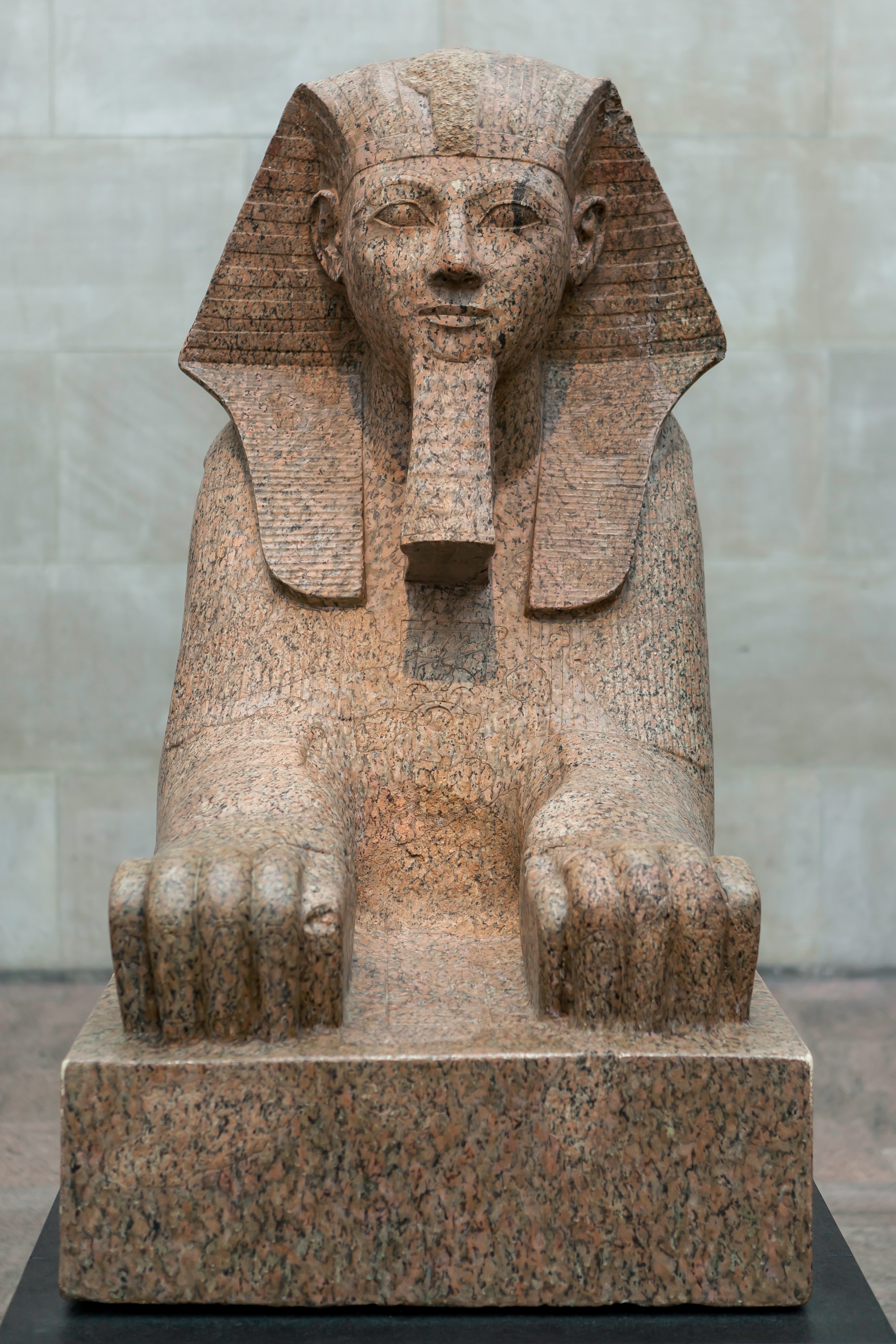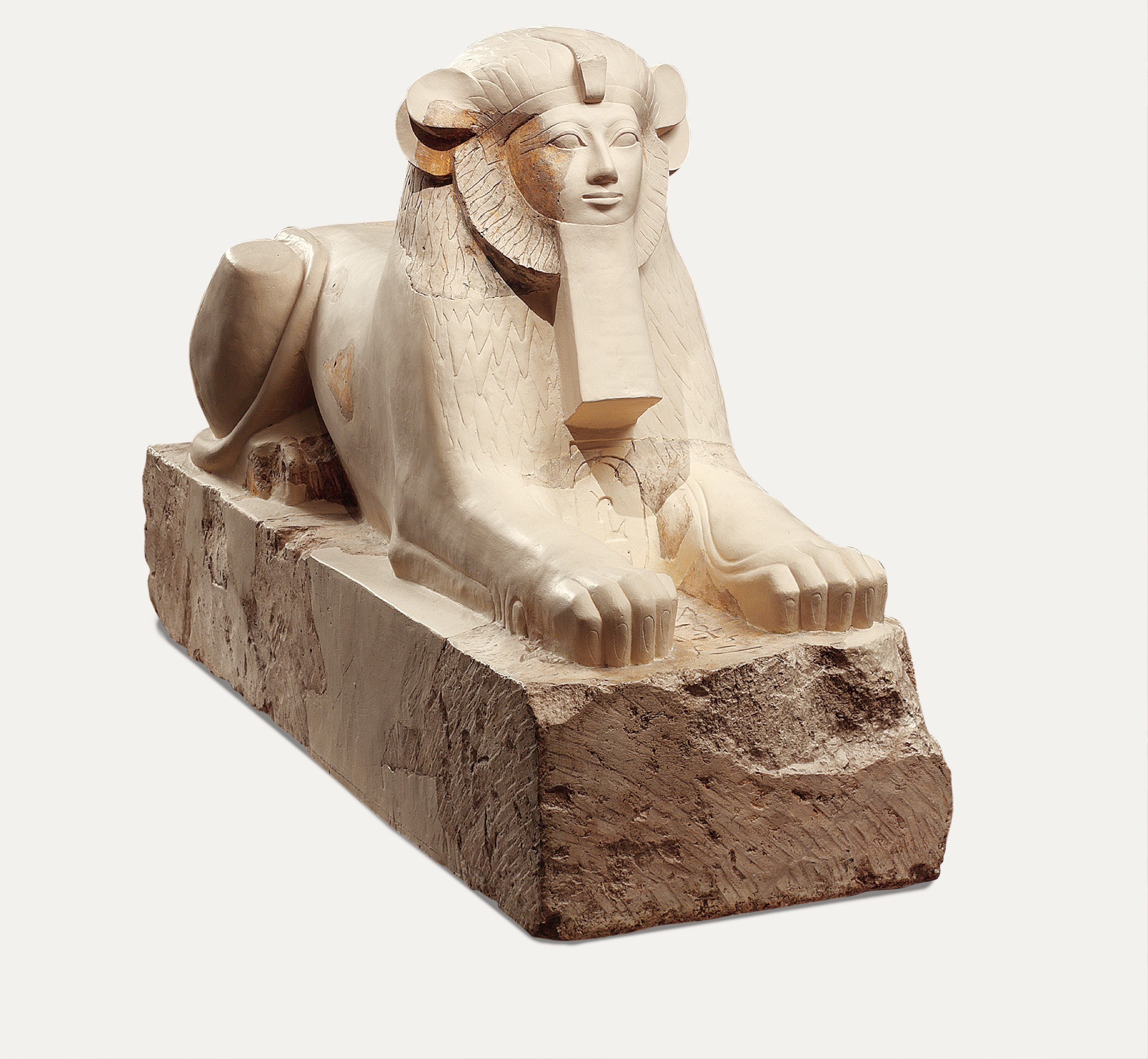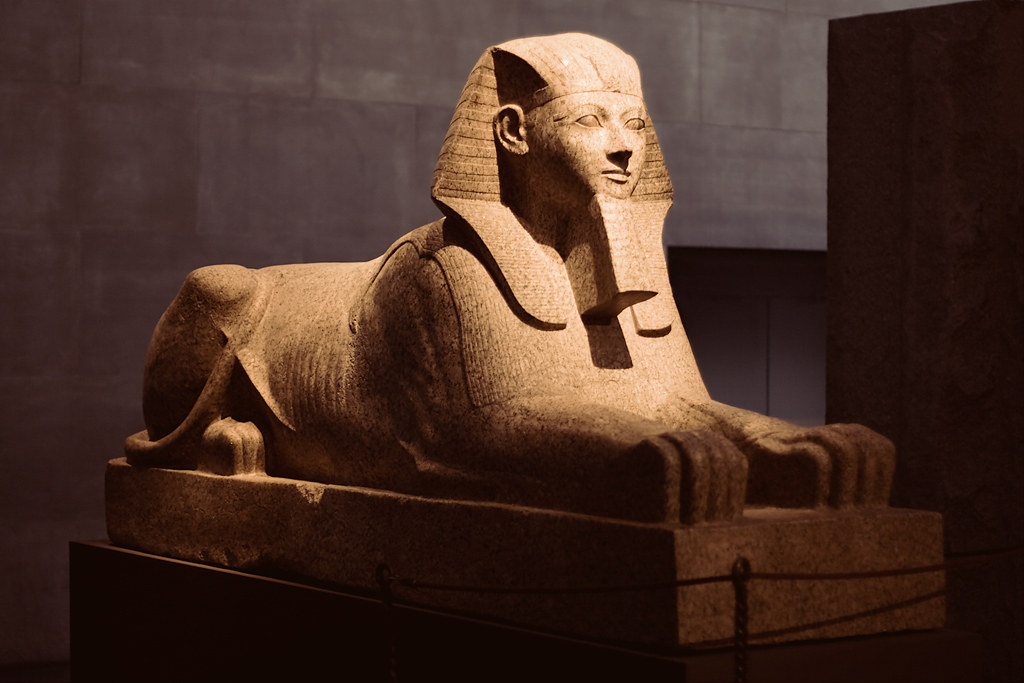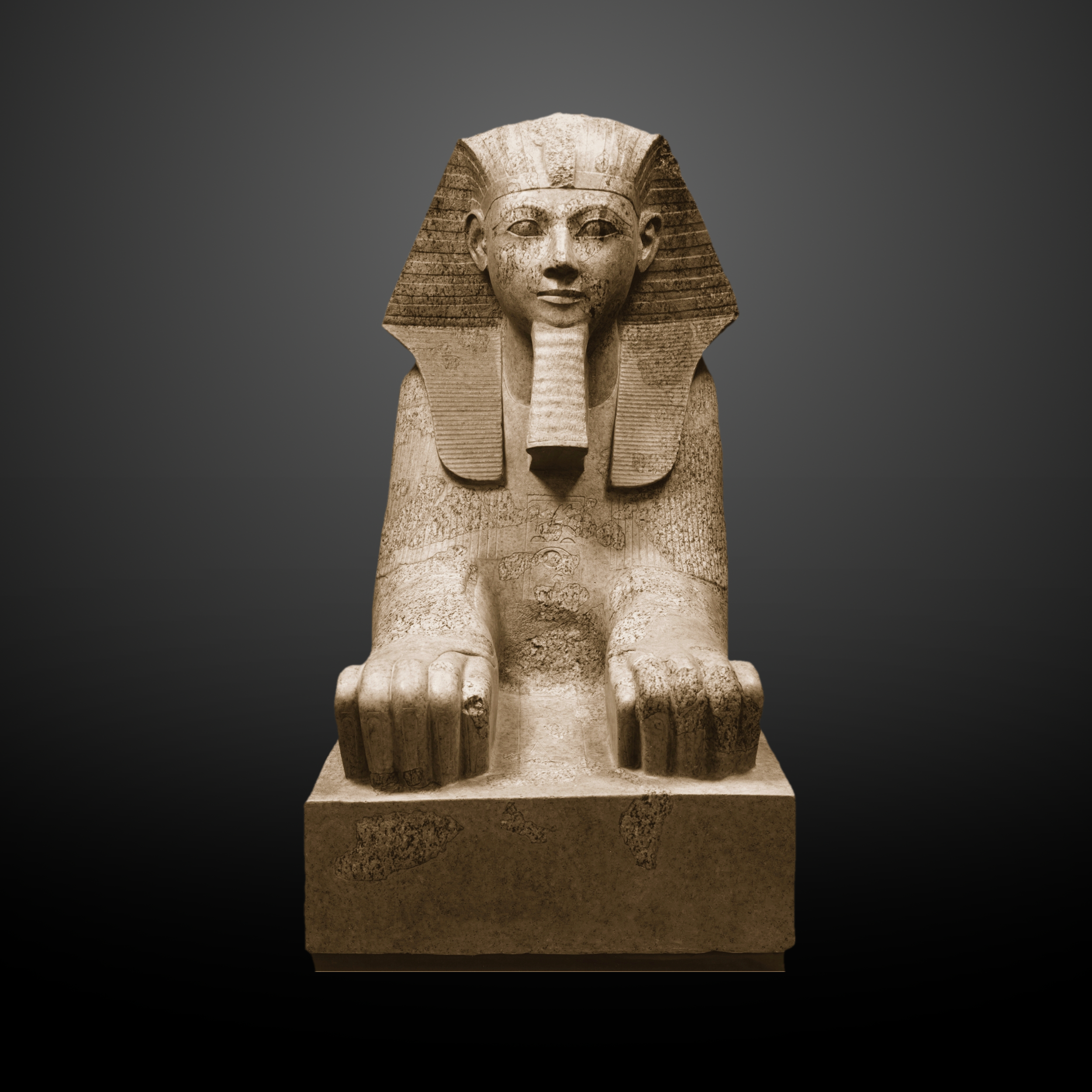Sphinx of Hatshepsut from ca. Who was the emperor of rome when jesus was born.
Sphinx Of Hatshepsut New Kingdom The Metropolitan Museum Of Art
Artists can emphasize the importance of a ruler by portraying him or her.

. The sculpture of the Sphinx of Hatshepsut depicts. The statue has the usual symbolic powerful muscles of the lion and the idealized face used for pharaohs. It was originally made for Hatshepsuts funerary temple at Deir el-Bahri which is a complex of temples dedicated to pharaohs of her family.
The Great Sphinx of Giza is a giant 4500-year-old limestone statue situated near the Great Pyramid in Giza Egypt. This seven-ton granite Sphinx of Hatshepsut has the body of a lion and a human head wearing a head-cloth and royal beard. 1479-1458 BCE the Metropolitan Museum of Art New York.
This colossal sized head and shoulder bust depicts Hatshepsut the female pharoah who came to the throne of Egypt in 1478BC and reigned for about 20 years. This is expressed as well in Hatshepsuts funerary tem-ple her greatest visible legacy. The sculpture of the sphinx of hatshepsut depicts.
It was carved from fine-grained gypsum and also depicts a mythological hybrid creature with a human head a lions body and the wings of a great bird of prey. Carved between the paws of the statue is a cartouche enclosing the pharaohs throne name Maatkare Truth is the Soul of the Sun c. No of course it is not that massive Great Sphinx in Giza Egypt but his history is also interesting.
This colossal sphinx portrays the female pharaoh Hatshepsut with the body of a lion and a human head wearing a nemes headcloth and false beard. The ancient Egyptian Pharaoh Hatshepsut lived and reigned in the 15th century BC. Once part of a line of sphinxes that guarded Hatshepsuts great mortuary temple at Deir el-Bahri across the Nile from modern Luxor the 11-foot-long sculpture now faces the center of the Great Hall.
It shows her with the body of a lion and the head of a king wearing the traditional royal headcloth the nemes. Published on 08 July 2017 This statue of the female pharaoh Hatshepsut is a prime example of the female kings penchant for blending male and female attributes in her artwork. This limestone and plaster piece depicts the female pharaoh Maatkare Hatshepsut as a sphinx.
Google Arts Culture features content from over 2000 leading museums and archives who have partnered with the Google Cultural Institute to bring the worlds treasures online. At the entrance to the show itself stands a granite statue more than eight feet high also reconstructed from fragments. The sculptor has carefully observed the powerful muscles of the lion as contrasted to the handsome idealized face of the pharaoh.
Thats why first what caught my eyes was Sphinx of Hatshepsut. This sculpture was part of a sphinx which was lost many years ago. Admin Send an email December 11 2021.
Two people in local dress and a donkey are in front of the Sphinx. Unless otherwise noted all details on the format provenance and original setting of both works are taken from the Metropolitan Museum of Arts catalog entries as are general impressions of each figures. The Collection Egyptian Art The Female Pharaoh Hatshepsut ca.
This item is a sphynx of Pharaoh Hatshepsut with a human head and lions body. It depicts the pharaoh bare chested in a kilt yet with female facial features and breasts. The self-portraits by John Coplans and Cindy Sherman ________.
Question 5 25 out of 25 points Hatshepsut kneeling depicts the ruler as kneeling in front of her co-ruler. Formal Analysis Today the Sphinx of Hatshepsut ca1479-1458 BC is located at The Metropolitan Museum of Art in New York. She has the body and mane of a lion with the head of a human.
Question 6 25 out of 25 points The ______________ was moved to higher ground in the 1960s when the Aswan High Dam was built. Sphinx of Hatshepsut First association with the Egyptian culture for me is related to Sphinx. She is considered to be one of Egypts most successful rulers.
It protected the royal funerary temple. New Kingdom On view at The Met Fifth Avenue in Gallery 115 This graceful life-size statue depicts Hatshepsut in female attire but she wears the nemes headcloth a royal attribute usually reserved for. Fals e True Fals e.
Question 5 25 out of 25 points hatshepsut kneeling. The Sphinx of Hatshepsut This colossal sphinx portrays the female pharaoh Hatshepsut with the body of a lion and a human head wearing a nemes headcloth and royal beard. At her burial location at Deir el-Bahri six sphinxes stood guard.
She made sure not to be mistaken for anything but a legitimate pharaoh. Artworks depicting men have historically referred to their powerful bodies or depicted them in leadership roles. A female dedicated as a male king There are no artworks that consciously counter stereotypical representations by showing men as vulnerable and women as powerful.
It depicts the queenking as a sphinx with a lions body and a royal portrait head commanding the entire space with grace and grandeur. She also wears the nemes crown associated with Egyptian kingship. This sphinx is one of several granite sphinxes that once stood in Hatshepsuts mortuary temple at Deir el-Bahri.
A female depicted as a male king a male pharaoh depicted as a woman King Tut disguised as Nefertiti Hatshepsuts pet Each answer shown is correct a female depicted as a male king Georges Seurats Sunday on La Grande Jatte Calendar stone Sun Stone late postclassic Aztec The Emperor Constantine I. A female depicted as a male king. Egypts Sphinx in front of a pyramid.
14791458 BC is a sculpture of Pharaoh Hatshepsut as a sphinx made of granite that is attached to a rectangular base on the bottom. JE 53114 JE 55191 is one of the red granite sphinx statues from the mortuary temple of Hatshepsut. The sculpture of the Sphinx of Hatshepsut depicts.
A female depicted as a male king. It would have earned its patron a special role in Egyptian and architectural histo-ry whether built by a female or male. The sculpture of the Sphinx of Hatshepsut depicts.
Sculpture depicts her as a sphinx. It depicts Hatshepsut as a king striding in a devotional attitude with arms. See more articles in category.
Measuring 240 feet 73 meters long and 66. It is believed that the statue was originally located in Western Thebes Deir el-Behri with the body of a lion and Hatshepsuts face nemes headdress and ceremonial beard. On view at The Met Fifth Avenue in Gallery 131.

Sphinx Of Hatshepsut New Kingdom The Metropolitan Museum Of Art

File Sphinx Of Hatshepsut Met 31 3 166 F White Jpg Wikimedia Commons

Sphinx Of Hatshepsut From Metmuseum Org This Colossal Sp Flickr

Sphinx Of Hatshepsut Illustration World History Encyclopedia

Sphinx Of Hatshepsut New Kingdom The Metropolitan Museum Of Art

Sphinx Of Hatshepsut New Kingdom The Metropolitan Museum Of Art

File Sphinx Of Hatshepsut Met 31 3 166 F Gradient Jpg Wikimedia Commons

0 comments
Post a Comment